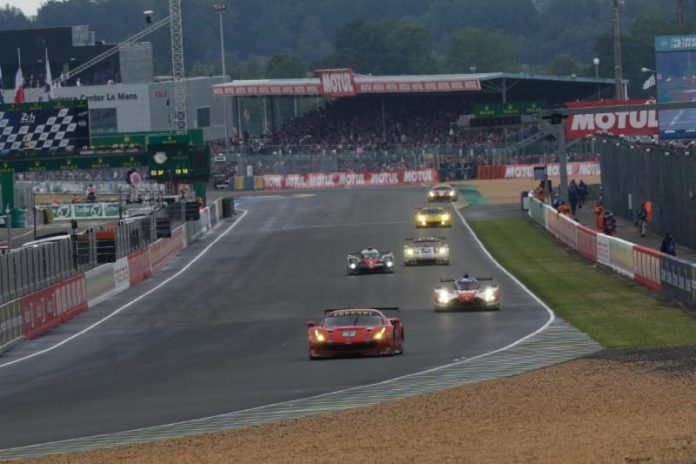Rick Mayer, race engineer of the Risi Competizione No. 82 Ferrari 488 GTE-Pro team, gives us a preview of this year’s 24 Hours of Le Mans, June 17-18, 2017.
Giancarlo Fisichella (Italy), Toni Vilander (Finland), and Pierre Kaffer (Germany) will pilot the Risi Competizione Prancing Horse for the eighth year for Team Owner Giuseppe Risi.
Overview: The Circuit de la Sarthe is a unique track as it is mostly public roads, except for the event days. The whole circuit is not available to test at any other time. The Le Mans test day is one of the most important test days of any series given the uniqueness of the venue. This time of year Le Mans weather can be extremely variable: wet, dry, hot or cold. We need to maximize track time to understand the tire options in the different conditions, finalize the race event starting setup, and get all the drivers comfortable and familiar with the many alarms, buttons, dials and switches.
The circuit is 8.5 miles long and just under a four-minute lap for the GTEs. Telemetry coverage we hope will be near perfect this year with advances that utilize cell phone towers to transmit the data from the car to the garage. The lap is so long here it helps to have something to monitor where the car is on track. It takes nearly 15 minutes just to do one timed lap if you include the ‘out’ and ‘in’ laps.
We have a total of eight (8) hours of practice time for the test day but the number of actual practice laps is low in comparison to a normal USA (or European) sprint race because of the long lap time. It almost always rains in testing and/or the race, so you just hope you have the setup and other essential testing sorted in the dry running.
Risi Competizione at the 2016 24 Hours of Le Mans race
Competition: This will be the most competitive GTE-Pro class ever for this year’s Le Mans, with Ferrari, Chevrolet Corvette, Porsche, Aston Martin, and Ford all fielding multiple cars with factory-supported teams and drivers. There are no weak teams or drivers; these are the best of the best in all respects. It is unlikely any cars will show their true pace as the BoP (Balance of Performance) can be adjusted between the test and the race. All the manufacturers are hoping to keep what they have or get a BoP advantage for the race week.
Setup: First, you need a super reliable car; you have to finish to win. It needs to be comfortable for all the drivers with no unpredictable handling tendencies. If the car is good in the Porsche curves it is probably good everywhere, so that’s a good gauge. The aero setup for Le Mans is like nowhere else we race. Every car has a special homologated Le Mans-only aero package to reduce the downforce and drag for competitiveness and equality. The long straights here are so important, with three of them being over a mile long and two more over 4000 feet. Teams will trim downforce to reduce drag for straight-line speed. There is a limit to reduced downforce. If you go too far you are too slow off the corners leading onto the long straights and the actual maximum speed in those sections can be slower. Part of the testing process is finding that limit. Every manufacturer has an ACO/FIA homologated Le Mans kit to reduce drag and give some parity between the different makes of cars. This is mainly to reduce front downforce that you balance with a substantial reduction in rear wing angle. The reduced wing is the main drag reduction. You need a good platform for the high speed and change of directions, so the setup is on the stiff side; there is only one slow corner at Le Mans. The majority of the track is smooth (surprisingly for every day roads), so there is not usually a grip issue. Additionally, the track gains grip in the test as the track rubbers in (rubber from the race tires sticking to the track surface). Of course, that is only if the rain doesn’t wash the rubber off! You always consider rain in the setup; seldom is the race totally dry.
Risi Competizione finished second in the GTE-Pro class at the 2016 24 Hours of Le Mans race
Test Day Methodology: Teams only have two four-hour sessions with a one-hour break. It is a full day of running. In the first hour the track will be low grip, dusty and dirty on the public street parts of the circuit. The dust and dirt being sucked off the track by the cars will look like spray from rain. You need to get a handle on the setup at the test. During the event week you need to be in ‘race mode’ and concentrate on race prep (car, drivers, equipment, crew, pit work, etc.) and not setup. All the Michelin-shod GTE-Pro cars will have three dry tire options to choose from and multiple damp to full wet tire options. Understanding the ‘windows’ these tires will work best in and cross-over points will be the main goal of this test. We will try to do long runs on tires, a stint being about an hour, to see how the balance changes and what the lap time degradation is throughout the run. We need to determine when and if it is advantageous to multi-stint tires in the race. Le Mans technical regulations only allow a limited number of dry tire sets to be used in the race. The quantity is not enough to change tires on every stop for the whole race, so we will have to multi-stint tires; double stinting tires is typical at Le Mans.
If teams have a good test and end with a comfortable reliable car and reasonably happy drivers then you can start working on race event planning and minor fine tuning of the car, drivers and crew for the race week.









